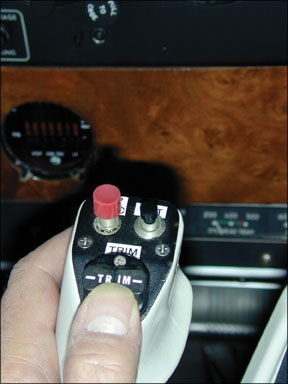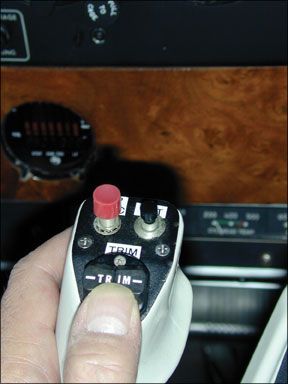Like most student pilots, I tended to fly with the type of casual lan my primary instructor described, none too deferentially, with the term “death grip.” Then somewhere along the way came my first introduction to that little knurled disk, which is usually just called the trim wheel. Trim? Huh? Whats that? What does it do? How does it work? How is it used? Power Steering Its nothing miraculous, really. Just think back to your childhood. If you were like 288 me and many other airplane-crazy kids, when you built a balsa wood glider and you started flying it, whats the first thing you adjusted? You adjusted its surfaces balance and deflection so it would fly the way you wanted it to, thats what. Unlike what youre doing today, there was no little man or woman in there jockeying the controls. Instead, the slots in the fuselage within which one could adjust the forward or aft position of the wings and horizontal stabilizer was strictly a hands-off affair. If youre younger, and your glider was made of that new-fangled plastic foam, you might have had the luxury of “bendable” control surfaces. Same idea; different solution. So it is with the real thing youre flying today. Trim tabs are small adjustable or hinged surfaces on the trailing edges of the elevator, rudder or even ailerons allowing us to fly with a featherweight touch instead of arm-wrestling exertions. Trim is aviations power steering. (Not only that, but unlike a car, its almost like hands-off power steering.) Its not too surprising then that control surface trim appeared as early as it did, when the German aeronautical engineer Anton Flettner first applied it to zeppelins, around 1905. Why Trim? Flying a trimmed airplane has major benefits: more relaxed flying, less fatigue. Flying with a tense, tight grip also means any distraction or other pilot-initiated movement tends to induce unintentional control surface movements. An out-of-trim airplane flies more slowly, and uses more fuel. And in fact, learning how to adapt to differences between various trim mechanisms is one of the best ways to improve your ability to make type transitions further along in your flying career. The name of the game is stability. It comes from the ingenious disbursement of an airplanes weight and the lift provided by its wings, where the center of gravity lies in front of the center of lift, and the “tail down” force we learned about in ground school counteracts that moment. Because of the horizontal stabilizers far greater moment arm, it doesnt have to create more than a small portion of the lift generated by the main wings. In fact, it isnt always a “down” force. Its so clever because its self-correcting: any increased airspeed yields more of that opposing moment, which brings the nose back up, decreasing airspeed. Likewise, enough of a decrease in airspeed means less “down force,” and the airplane pitches down to “try” to regain the lost speed. Its for this reason that Wolfgang Langewiesche spoke of an airplanes “gaits,” and this is why-even though you actually trim for an angle-of-attack-you empirically trim for an airspeed. The airplanes fervent attempt to return to its trimmed angle of attack is partially responsible for phugoids, or porpoising. (Theyre worst at a forward CG; of course, stability itself is worst at an aft CG.) On the other hand, theres also an inherent response lag from control system friction. In reality you are trimming somewhere in a “trim speed band.” In some airplanes this can be quite wide, and stick forces alone may not be enough to avoid reaching dangerously slow airspeeds-although Part 23 aircraft certification rules do limit this speed range to plus or minus 10 percent of the selected speed. How It Works So what is a trim tab? Well, since the empennage has a large moment arm, because trim tabs are mounted on the trailing edge of a control surface, far beyond the hinge line, they have a lot of leverage. The small force produced is enough to deflect the entire elevator (or rudder, or aileron). Aside from the many slow, early airplanes with such narrow speed ranges that they didnt have or need trim, the simplest type of all is the fixed trim tab: you fly, you land, you tweak it, you go fly some more, etc. Then there is the adjustable trim tab, and in fact on some large airplanes it is the small “servo” tab that connects to the primary controls. Servo tabs in general deflect opposite to primary control surfaces and thus assist in moving them, lessening control forces. Anti-servo tabs, however, add to the force required, but improve effectiveness. Other types of trim control are the adjustable stabilizer, like the window-crank type in a Cub, which lowers or raises the leading edge of the horizontal stabilizer, or the trim tabs on the back of the center-hinged stabilator on an Arrow, which is the alternative to separate stabilizer and elevator systems. Mooneys, on the other hand, move the entire tail when trimming. Dont ask me why there are so many types; it could be engineering arrogance, or it could be patent infringement anxiety. Managing Trim Regardless of how the various systems work, trim is not a “set it and forget it” affair, however. You can trim for an airspeed (or a narrow range at least) but that only applies for a given configuration (flaps, power) and CG. I almost learned that lesson the hard way about 10 years ago when I took my father and sister for a short hop in a 172 from the Sussex Airport in New Jersey. They were in the back seat. I did my “flaps, trim, doors, transponder, strobes” pre-takeoff check and we were off, but to my considerable alarm, the airplane wanted to climb at a ridiculously steep angle. It took a moment-and it was a very frightening and alarming moment-for me to realize what was wrong. Sometimes acquiring experience in aviation involves suffering the exam before receiving the lesson, but it was “heart-in-the-mouth” time for me. Both family members together didnt weigh much over 300 pounds, but that rearward shift in the CG, even though we were well within the moment envelope, was almost enough to do us in. In the 172, a pre-takeoff checklist item includes setting the elevator trim to the “takeoff” position. It should have been set to better anticipate the extra rearward loading of my innocent passengers. In other airplanes, later Bonanzas, for example, the elevator trim is set within a range or to specific values: One for when theres little payload in the back and one for when youre hauling Grandmas steamer trunk. Many airplanes handling ills can be easily cured by judiciously bending their fixed trim tabs. Going back to the 172, if you find your favorite Skyhawk cruises with the ball out of its cage, you can rest your foot on the rudder toward which the ball is displaced. This will deflect the rudder enough to correct the out-of-trim situation youve encountered. Most-if not all-Skyhawks have a fixed rudder trim tab thats easily bent. If you find you need “just a little” right rudder to center the ball in cruise, next time you preflight or at the next fuel stop, take a moment to 
If you find the balls now centered but the airplane wants to fly with one wing low-or the other wing high, as the case may be-youve discovered a misrigged airplane. Its not an airworthiness issue, but it is something a qualified mechanic must tackle to make right.
The most common mistake pilots make when considering trim is using it as a primary control. Instead of trimming the airplane into the desired attitude, place it there first, then trim off the control pressures. Learning how trim systems work, which systems are installed on your airplane and how to disable them in a pinch are what its all about.
Jeff Pardo is a freelance writer and editor who holds a Commercial certificate for airplanes, helicopters and sailplanes.




